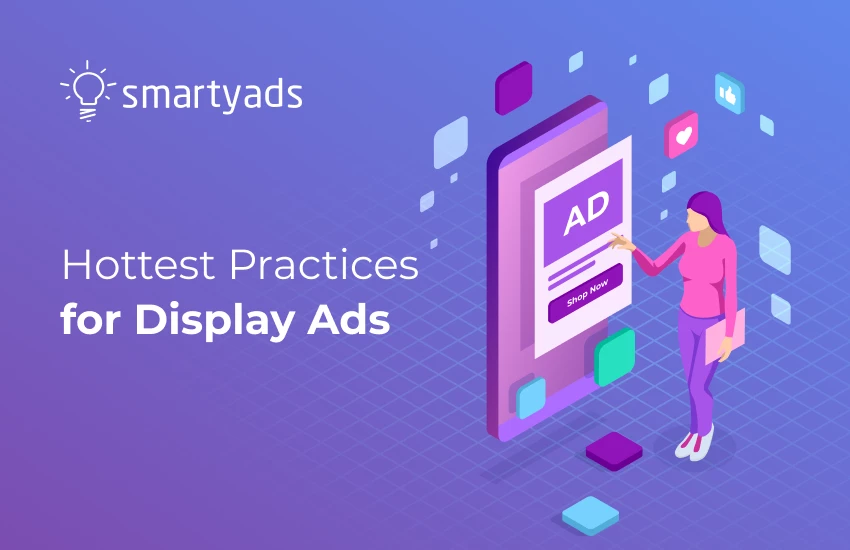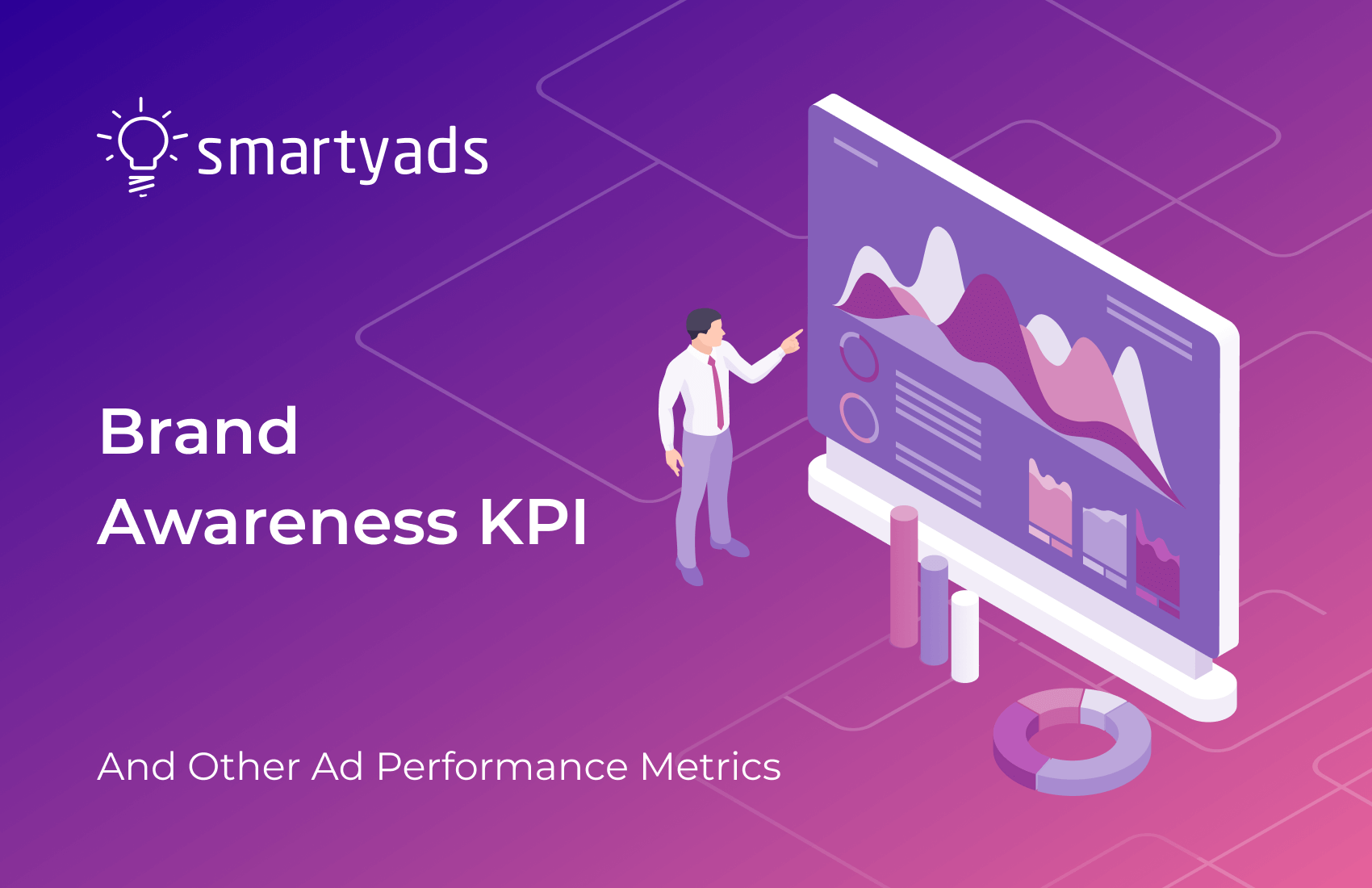Global digital advertising expenditure will reach $870.85 billion by 2027, reflecting the growing preference for banner ad placement, video ad formats, and display campaigns.
When we say "display ads", the first thing that pops into our minds is display banners. However, in 2025, display formats span more than display banners; they also incorporate other ad types with animated elements and inbuilt media.
So, what are display ads? What are digital ads best practices, and how to help your creative find the right ad space?

A quick word about display advertising
So, what are display ads? Digital display ads appear in a lot of formats — static ads and dynamic ones. Those are banners, video ads, search ads, Google ads, and images placed on websites, apps, or social media platforms to promote a product, service, or brand.
By the way, global digital marketing stats underline how quickly display advertising will be growing in 2025-2030:
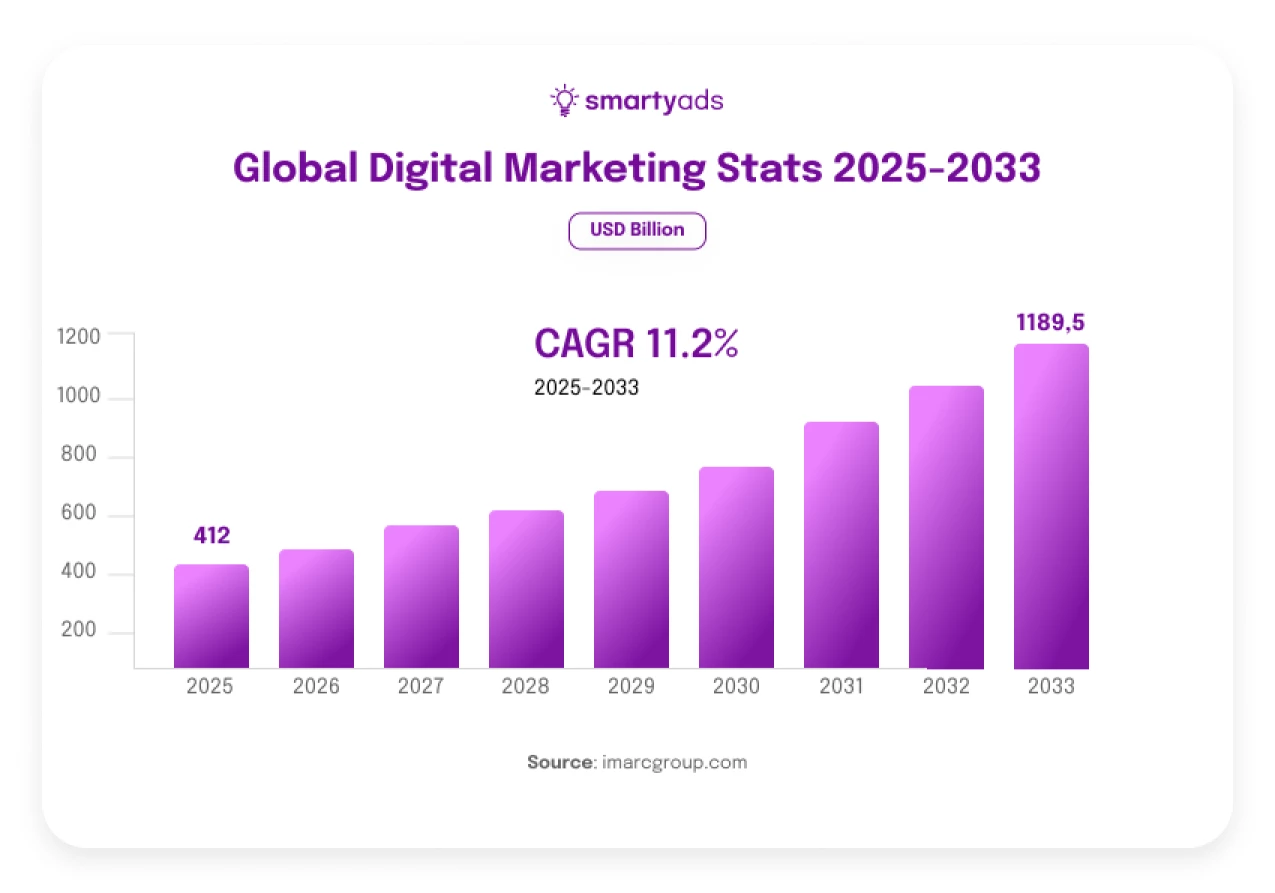
What is it good for?
Display advertising allows businesses to reach a large audience, generate brand awareness, and target specific demographics or interests through advanced targeting options.
Also, display ads are good for raising conversion rates. However, their primary task is to generate brand recall and increase brand recognition.
Here you can find display advertising examples for your inspiration.
These campaigns can be orchestrated on a cost-per-click (CPC) or cost-per-impression (CPM) basis, often navigated through digital advertising platforms or the Google Display Network. Notably, integrating the best display ads network into your digital strategy can significantly enhance visibility and engagement, whether used individually or alongside other networks for maximum reach.
How popular are display ads?
Programmatic digital display ad spending will hit the bar of $168.02 billion only in the US market alone, which signifies that brands are looking for the opportunity to automatically adjust bidding strategy, serve display advertising campaign messages across the channels, and target people on different platforms and specific websites.

What are the main drivers of display campaigns?
A display campaign is a very popular choice among brands, especially in industries such as automotive, computing, and retail.
6 display ads that you can use
- Banner ads. These are rectangular or square ads displayed at the top, bottom, or sides of a web page. They usually contain images, text, and a call-to-action button;
- Native ads. These ads are designed to blend in with the content of the website or app where they are displayed. They often mimic the look and feel of the surrounding content, making them less disruptive to the user experience;
- Video ads. These display ads appear in the form of video content and are displayed before, during, or after a video the user is watching;
- Rich media ads. These interactive ads include animations, video, audio, or other multimedia elements to engage the viewer and enhance the user experience;
- Pop-up ads. These ads open in a new window or tab and appear on top of the current web page. They can annoy Internet users and are less common than other display ads;
- Interstitial ads. These full-screen display ads appear between content or when a user transitions from one page to another. They are often used in mobile apps and games.
Banner ad campaigns
A banner ad unit is the most common one on the Internet. Typically those are commercial images that user encounters in search engines, inside of web pages, and in articles.
Benefits of banners
Cost-effective. Banner ads can be very effective because they allow advertisers to reach a large audience quickly and easily. One of the biggest advantages of banner ads is their versatility — they can be used to promote just about anything, from products and services to events and promotions.
And because they are typically displayed on high-traffic websites, banner ads can help businesses reach a broad range of potential customers.
Good for small brands. Another benefit of banner ads is that they are relatively easy and inexpensive to create and manage. They build brand awareness easily. Even small businesses with limited budgets can use banner ads to promote their products or services.
Measurable. Static banners are also highly measurable, so advertisers can track their performance and adjust to improve display ads' effectiveness over time.
There are different banner ad formats:
- Rich media banners
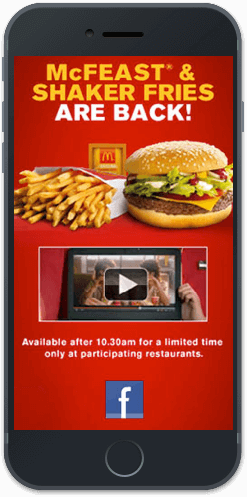
- Mobile, interstitial & app banner ads
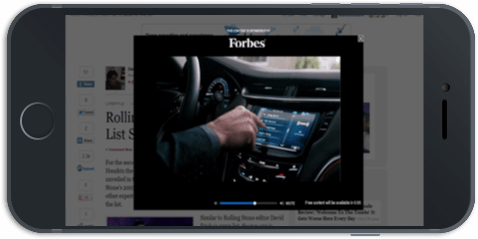
- Video banner ads, custom ones, and more

What format, size, and style should you use for banner ads?
Format: use JPEG, PNG, or GIF format for your banner ads. Choose a standard size for banner ads, such as 300x250 or 728x90 (or use the most popular display banner ad sizes). Display ad design best practices: use eye-catching and attention-grabbing visuals and concise and clear core messaging. Banner ad design best practices should include a strong call-to-action to encourage clicks. Effective display ads should also contain a link redirecting the user to the landing page (preferably white background).
Native ads
Native ads attract users' attention because they are the least intrusive — they imitate the form and function of the content they are placed in. Normally they come in form of recommendation widgets, sponsored content, in-feed ads, and more.
Benefits of native ads
They increase brand awareness. Native ads can be highly effective because they seamlessly blend in with the content around them. By appearing in contextually relevant placements, native ads can help increase brand recognition and awareness.
They are non-intrusive. Because they are less intrusive than other forms of advertising, they can enhance the overall user experience for website visitors.
They deliver great reach. Because they are often delivered on multiple platforms and devices, native ads can help brands reach a wider audience and increase their visibility online.
There are different native ad formats to choose from:
- In-feed ads (appear on social media)

- Mobile web native ads

- Content recommendation widgets and more

Banner ads best practices:
With native units, you can create responsive display ads for programmatic and Google display campaigns alike.
The format, size, and style of native ads will depend on the platform where they will be displayed. However, in general, native ads should match the look and feel of the surrounding content to blend in seamlessly.
They should use a similar color scheme, typography, and imagery. As for size, native ads should be designed to fit the available ad space while still being clearly visible and legible.

Video ads
Video commercials persuade users, tell a brand story, or showcase a product in detail. One ad is normally placed in the middle of video content in the video player. Brands create ads in the form of videos to amplify their display advertising strategy on various channels, including YouTube and CTV.
Benefits of video ads
They are memorable. Using visuals, music, and storytelling, brands can create an emotional connection with their audience, leading to increased brand awareness and loyalty.
They convert better. Users trust the ad more because they can see the product in detail. As a result, users are more likely to click on the banner after videos, which redirects the viewers to landing pages.
They are targeted. Video commercials support demographic targeting as well as other types of targeting options. This ad increases the chances of conversion and reaching a return on investment.
Here are some examples of video ad formats:
- In-stream ads

- Video interstitial ad

- In-banner video

Best practices for great video commercials:
The format of the ad will depend on the platform where it will be displayed. For example, a video ad on YouTube may have different format requirements than a video ad on Facebook, Instagram, or videos placed via the Google display network.
The video ad size should also be optimized for the platform where it will be displayed. A shorter length is better for social media platforms, while a longer form may be more effective for streaming services. A longer video commercial may effectively stand out when placed on a website or landing page.
Regarding brand consistency — the video should align with the overall aesthetic and messaging. The style can range from animated explainer videos to live-action product demos, depending on the brand's goals and target audience.
Rich media ads
This type of digital is one of the best practices for display ads. They typically incorporate interactive elements. They can appear in the form of animated banners. They can include video, audio, and other features to encourage user interaction and engagement.
Benefits of rich media ads
They drive more clicks. These highly interactive and attention-grabbing ads can increase engagement and drive more clicks and conversions.
They are engaging. The interactive ad offers more creative flexibility than a traditional one, allowing brands to showcase their products or services in a more dynamic and engaging way. They can also be optimized for different platforms and devices.
They are easy to measure. These ads provide more detailed performance metrics than traditional ones, allowing brands to track real-time engagement and conversion rates. While creating display ads like these, brands can optimize their campaigns for maximum effectiveness and track user interactions with ad tags.
There are different types of rich media ad formats:
- Interactive banners

- Expandable banners

- Pushdown rich media ads

You can also serve your own banner ads (of custom design and dimensions).
Pop-up ads
Pop-ups are responsive display ads that appear in a separate window or "pop-up" when a user visits a website or clicks on a link. These ads are typically designed to be attention-grabbing and can feature various content, such as text, different images, or videos.
Benefits of pop-ups
They effectively grab the user's attention and drive clicks and conversions. They can be designed to be visually striking and attention-grabbing, encouraging users to engage with the ad and visit the brand's landing page.
They are highly targeted, allowing brands to reach specific demographics or interests. Using data and analytics, brands can deliver their message to the right people at the right time, increasing the chances of conversion and return on investment.
They are easily placed. Like search ads, pop-ups can be placed contextually, which eliminates the use of third-party cookies.
Example of the desktop pop-up:

Example of the mobile pop-up:

Best practices for pop-ups:
Uploaded display ads like pop-ups should be selected based on the platform and user experience and designed to be non-intrusive and user-friendly.
The size of pop-up ads should also be optimized for the platform and user experience. They should be large enough to be noticed and grab attention but not so large that they are obstructive.
Interstitial ads
Interstitial ads are a type of digital advertising that appear in between content or when a user is transitioning from one page or app to another. These ads can be full-screen or pop-up windows and contain various content such as text, images, or videos.
Benefits of interstitials
They generate clicks and conversions since interstitial display ads are often viewed as part of the user's natural navigation or browsing experience on a website. The ads can be designed to be visually striking, attention-grabbing, and thus very effective.
They are targeted. Brands channel their message in the market at the right time, increasing the chances of conversion and return on investment.
They are customizable. Interstitials can be customized to align with the brand's overall aesthetic and messaging. They can be optimized for various platforms and devices and designed to promote specific products or services.
Examples of rich media interstitials that can be served in desktop and mobile environments:

Best practices for interstitial ads
Interstitials are easy to implement, they stand out among other commercials, and they can be used for remarketing audiences on various platforms.
In terms of format, interstitial ads can take many different forms, including full-screen ads, pop-ups, or rich media ads. The format should be selected based on the platform and user experience and designed to be non-intrusive and user-friendly.
The size of interstitial ads should also be optimized for the platform and user experience.
8 Best practices for display advertising
1. Dive into AI and Machine Learning
Imagine this - you're optimizing your display ads using the power of AI and machine learning. These intelligent technologies can analyze large amounts of data, identifying trends and valuable insights to ensure that your ads effectively reach the right audience. Moreover, they are constantly testing ad elements to deliver your best possible version. Just think about the significant advantage you would gain!
2. Get Interactive and Go Immersive
Expand your marketing horizons. Instead of the usual, captivate your audience with ads that draw them in. Envision offering them a 360-degree video experience, an AR journey, or engaging them with an interactive poll for their opinions. It's not just about catching their eye; it's about creating unforgettable moments that leave a lasting impression, reinforcing brand affinity and retention.
3. Put Privacy at the Forefront
In the world of advertising, showing respect is crucial. Embracing a privacy-first approach involves being open about how you gather data, protecting it, and returning control to your audience. It's not just about being polite; it's about building trust and staying ahead as privacy standards change.
4. Unleash Creativity and Tell a Tale
Remember this text: "In a crowded sea of ads, storytelling can help your ad stand out. By incorporating creative storytelling into your display ads, whether through a series of narrative ads or visually compelling messages, you can make a real impact. Making an emotional connection can make a big difference in driving engagement and conversions."
5. Master the Art of Ad Sequencing
Just imagine taking your audience on a journey through a series of ads, like guiding them through a captivating story or a well-crafted sales funnel. Each ad serves as a chapter in a book, gradually revealing more information and skillfully leading them closer to making a purchase. It's all about constructing a consistent narrative that shapes your brand's identity in their minds over time.
6. Personalize with Dynamic Content
Why settle for the same old ad when you can tailor it to each viewer? Dynamic content customizes your ads based on the viewer's details - such as location, time of day, or their previous interactions with your site. It's like welcoming an old friend; you understand what interests them.
7. Optimize Like Mobile's Your Main Stage
In today's mobile-centric world, it's essential that your ads seamlessly integrate into the small screens that people are spending more and more time on. By optimizing for smaller screens, ensuring easy touch interactions, and leveraging intelligent features like geotargeting, you can position your ads right where your target audience is. Find more tips for advertising campaign optimization here.
8. Embrace Sustainable Advertising
Make sure your ads line up with the principles of a more environmentally friendly world. Opt for energy-efficient servers, platforms that are conscious of their carbon footprint, and messages that reflect eco-friendliness. This is about sending a message that connects with environmentally conscious consumers, demonstrating that your brand stands for more than just making money.
Incorporating these insights into your display ads strategy isn't just following trends – it's setting them, ensuring your brand not only stands out but also signifies something deeper to your audience.
To sum up
You don't need to be a rocket scientist to create effective Google display ads or programmatic campaigns. Still, there are display ad best practices that can help you improve your performance. Be selective with your choice of images and text, and make sure they complement each other well for each display format. Also, ensure you've addressed any regulatory requirements before getting started.
Launch and run efficient display campaigns on SmartyAds DSP!
FAQ
Always feature your logo, a clear USP (unique selling point), and a bold call-to-action (CTA). Together, they boost brand recognition and guide users toward the next step. Make sure that the design is clean too as platforms now prioritize creatives that are visually appealing.
Match your ad content to audience intent and use insights from analytics to personalize where possible. Relevance—from demographics to behavior—drives engagement and increases the likelyood of conversion. For display ads you can apply the varied set of targeting options, OS, device type, age range, location, and more.
Always use responsive ad designs that adapt to mobile, tablet, and desktop without losing clarity. Lightweight file sizes improve loading speed, which keeps viewers engaged and prevents drop-off. Alternatively, use creative auto-resize on SmartyAds DSP.
Consistently run A/B tests on elements like copy, visuals, sizes, and CTAs to see what resonates. Use campaign data to refine targeting, adjust creative direction, and focus budget on winning combinations. Over time, this data-driven approach can greatly improve both engagement and conversions.

